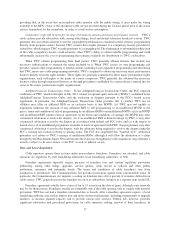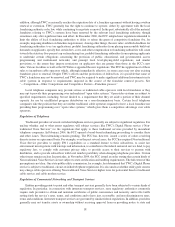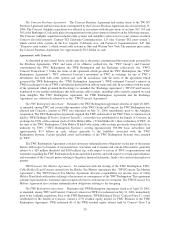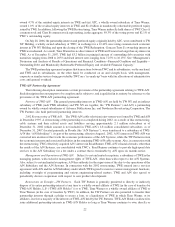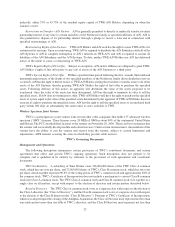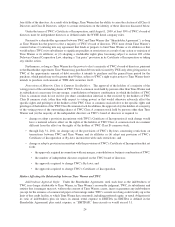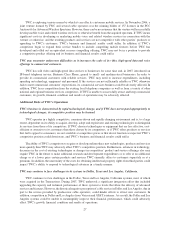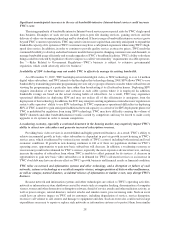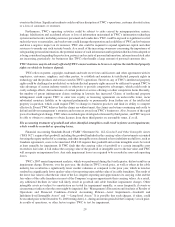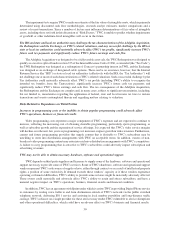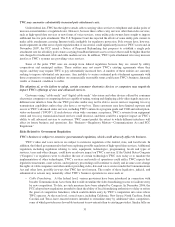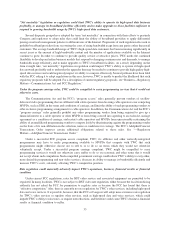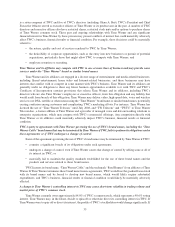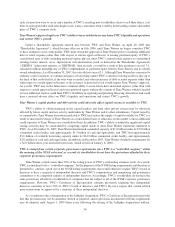Time Warner Cable 2007 Annual Report Download - page 31
Download and view the complete annual report
Please find page 31 of the 2007 Time Warner Cable annual report below. You can navigate through the pages in the report by either clicking on the pages listed below, or by using the keyword search tool below to find specific information within the annual report.Any inability to compete effectively or an increase in competition with respect to video, voice or high-speed
data services could have an adverse effect on TWC’s financial results and return on capital expenditures due to
possible increases in the cost of gaining and retaining subscribers and lower per subscriber revenue, could slow or
cause a decline in TWC’s growth rates, reduce TWC’s revenues, reduce the number of TWC’s subscribers or reduce
TWC’s ability to increase penetration rates for services. As TWC expands and introduces new and enhanced
products and services, TWC may be subject to competition from other providers of those products and services,
such as telecommunications providers, ISP and consumer electronics companies, among others. TWC cannot
predict the extent to which this competition will affect its future financial results or return on capital expenditures.
Future advances in technology, as well as changes in the marketplace and in the regulatory and legislative
environments, may result in changes to the competitive landscape. For additional information regarding the
regulatory and legal environment, see “—Risks Related to Government Regulation” and “Business—Competition”
and “—Regulatory Matters.”
TWC operates its cable systems under franchises that are non-exclusive. State and local franchising authorities
can grant additional franchises and foster additional competition.
TWC’s cable systems are constructed and operated under non-exclusive franchises granted by state or local
governmental authorities. Federal law prohibits franchising authorities from unreasonably denying requests for
additional franchises. Consequently, competing operators may build systems in areas in which TWC holds
franchises. The existence of more than one cable system operating in the same territory is referred to as an
“overbuild.” In the past, competing operators—most of them relatively small—have obtained such franchises and
offered competing services in some areas in which TWC holds franchises. More recently, incumbent local
telephone companies with significant resources, particularly Verizon and AT&T, have obtained or have sought to
obtain such franchises in connection with or in preparation for offering video, high-speed data and digital voice
services in some of TWC’s service areas. See “—TWC faces a wide range of competition, which could negatively
affect its business and financial results” above. Verizon and AT&T are continuing to upgrade their networks to
enable the delivery of video and high-speed data services, in addition to their existing telephone services.
Increased competition from any source, including overbuilders, could require TWC to charge lower prices for
existing or future services than TWC otherwise might or require TWC to invest in or otherwise obtain additional
services more quickly or at higher costs than TWC otherwise might. These actions, or the failure to take steps to
allow TWC to compete effectively, could adversely affect TWC’s growth, financial condition and results of
operations.
TWC faces risks relating to competition for the leisure and entertainment time of audiences, which has
intensified in part due to advances in technology.
In addition to the various competitive factors discussed above, TWC’s business is subject to risks relating to
increasing competition for the leisure and entertainment time of consumers. TWC’s business competes with all
other sources of entertainment and information delivery, including broadcast television, movies, live events, radio
broadcasts, home video products, console games, print media and the Internet. Technological advancements, such
as VOD, new video formats, and Internet streaming and downloading, many of which have been beneficial to
TWC’s business, have nonetheless increased the number of entertainment and information delivery choices
available to consumers and intensified the challenges posed by audience fragmentation. The increasing number of
choices available to audiences could negatively impact not only consumer demand for TWC’s products and
services, but also advertisers’ willingness to purchase advertising from TWC. If TWC does not respond
appropriately to further increases in the leisure and entertainment choices available to consumers, TWC’s
competitive position could deteriorate, and TWC’s financial results could suffer.
TWC’s competitive position and business and financial results could suffer if it does not develop a compelling
wireless offering.
TWC believes that broadband cable networks currently provide the most efficient means to deliver its services,
but consumers are increasingly interested in accessing information, entertainment and communication services
outside the home as well.
26



